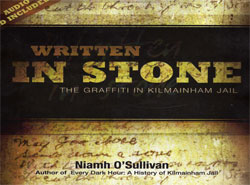 “This grand little book was devoured, from cover to cover, in one sitting,” writes veteran republican Gerry O’Hare, “such was the quality of the writer’s skill in weaving us through the story of the graffiti, pictures and history within the grim, grey walls of Kilmainham.”
“This grand little book was devoured, from cover to cover, in one sitting,” writes veteran republican Gerry O’Hare, “such was the quality of the writer’s skill in weaving us through the story of the graffiti, pictures and history within the grim, grey walls of Kilmainham.”
Gerry O’Hare reviews Niamh O’Sullivan’s ‘Written In Stone’
More a pictorial record of the graffiti in the prison cells than a history of Kilmainham Jail, those who have visited the jail will delight in retracing their footsteps with the aid of its photos – and the help of a DVD, included in the price of the book, assisting both the general reader and students.
The author explains, in her introduction, that she wanted to capture that “veiled world of the writings left behind on Kilmainham’s walls by its former inmates”.
This she does, both in her script and the excellent photographs, taken with a 35mm camera. Most she captured herself, while others are published with the permission of the officials of the jail and Museum. A few of her pictures are allowed by permission of the families of their late owners, including those of Sighle Humphries and Risteard Mulcahy.
I warmed to the book particularly because of the personal experiences of myself and my three children, Terry, Jane-Frances and Rory. When I was released from Portlaoise Jail in 1975 my former wife Rita still languished in Limerick Jail for republican activities. Not long after my release, my late and dear friend, Eamonn MacThomais, invited us for a private visit to Kilmainham – then a hive of activity with many volunteers working to restore the Jail.
As Eamonn was showing me what work was being carried out, we heard shrieks of delight and laughter from my children. Rushing to the cell from where the sound was coming, we discovered they had spotted graffiti in the wall of the cell that simply said ‘Free Rita O’Hare’.
Rita was also facing extradition at that time.
Whilst well-meaning support for Rita was naturally welcome, I was also slightly embarrassed that someone had written on the wall of a cell at a time when hardworking volunteers were trying to clean and restore it! However, Eamonn saw the funny side of the incident – and as I read Niamh’s book it brought back warm memories.
Since that time, the history of the restoration work, and its many supporters and well-wishers, has being well-documented.
Here, in this book, Niamh brings us into the world of former prisoners who served sentences and many others who went to meet their deaths by execution at the hands of Free State forces. Niamh seems to understand the point I was trying to make about my children when she succinctly says, “I was fascinated by the original writings on the walls: those left behind by former inmates – as opposed to the large volume of later scribblings by post-1960s tourists and visitors”.
She tells us there are levels of graffiti in the old prison, two parallel worlds existing side by side: that of the authentic, yet brief, 1915-1924 span of prison inscriptions, and the modern (1960s to 1980s with some 1990s, and even post-2000 examples – ‘Kilroy Was Here’ material).
In some instances, the old and the new occupy the same miniscule space.
She lets us know of her frustrations when she adds: “Drawing the necessary distinction between the two has, on occasion, proved a rather difficult task”.
It was not just republicans who left their mark on the walls of Kilmainham. The author dwells briefly on other visitors – British soldiers imprisoned for their own misdemeanors. During the period of the First World War, we learn, that in the east wing, Private Patrick Reddy, a young man, served eighty-four days in Kilmainham for minor offences. He was entitled to both the Victory Medal and the British War Medal once the war had ended. He never collected either as he died in France in 1917. Reddy was a Dubliner and just 24-years-old.
The author says: “His ghost lingers just enough to prompt us to remember all those Dublin, Irish, boys and men who gave their lives for their country, just as surely as the executed men and boys of 1916 did, but on a different stage. Their pain in the past has been less visible but we should never allow it to be less real”.
The most frequently photographed piece of graffiti is located in the East Wing, in Grace Gifford Plunkett’s cell. It is her original painting of the Madonna and Child and it was the first graffiti to be officially restored by Thomas Ryan RHA.
For long periods the jail was allowed to fall into decay before, in the 1960s, concerned people undertook to save what was left and try and restore the worst parts.*
It was the work of the Kilmainham Jail Restoration Society, followed by the OPW, to stabilise the building.
One problem the volunteers had was that the majority of the writings were made by black pencil on tin and the aged, already crumbling, plaster walls -which Niamh tells us that, even to this day, are subject to continuing expansion and contraction brought about by the Irish weather.
She is at pains to warn us that there is no guarantee that the decaying process can be stopped. Indeed, there is a danger that as restoration continues very carefully, it does not accelerate the decay.
In order to safeguard what is still there, glass barriers – that do not interfere with inscriptions – were erected along with wooden barriers, to prevent visitors touching the walls. Cell doors were also locked.
All this serious work is being carried out to save the graffiti. The hope is that there will eventually be a solution to finally preserve the already fragile plaster. In the meantime the need for more funds is vital.
Former female prisoners will read avidly that some five hundred women were incarcerated in Kilmainham between February and September 1923. Up pops Sighle Humphreys again, a prominent Cumann na Ban organiser, veteran dispatch carrier, propagandist and locator of safe houses for the IRA. Aged just 24 at the time, she spent most of 1923 in Kilmainham, the “north Dublin Union Internment Camp” and Mountjoy Prison.
She didn’t spend her time idly. Along with her formidable mother, Nell, and her Aunt Anna Rahilly, she organised various games, including rounders and handball with the other female prisoners. She taught Irish classes, went on hunger strike and was finally transferred out of Kilmainham in September, along with the remaining prisoners, to make way for an influx of male republican hunger strikers.
She was among the last batch of women prisoners released from Mountjoy in December 1923. Her cell in the Old West Wing, we are told, is unique.
According to the author, she stamped it firmly with her own distinctive thoughts and ideals, with various messages surviving to this day, both in Irish and English.
On her cell door is her name: ‘Sighle Nic Amhlaoibh’. Nearby is a scrawl ‘An Phoblacht Abu’, interspersed throughout her cell with the logo of Cumann na mBan (a rifle badge with the initials ‘C na mB’ intertwined).
Her disparaging thoughts of the Free Starters leaves us in little doubt. “Men and measures may come and go, but principles are eternal”, and the Irish “Ni Siochain gan Saoirse” (No peace without freedom).
There are other amazing stories about female prisoners but the reader does not want me to spoil the tales that lie ahead. Their’s and the male prisoners scribblings and art-work will hold you enthralled and the author is to be praised for her dedication in, not just working on the restoration work, but for whetting our appetites for the full history of Kilmainham.
I fully recommend this fine contribution by a dedicated scribe and historian. It should be in every republican home as a starting point for children to learn about a period of our troubled past.
Eamonn Mac Thomais can rest peacefully in the knowledge that hundreds of restorers, continue unselfishly to carry on the vital work begun by Eamonn.
Readers can also help by making a donation to the prison project.
Written In Stone – The Graffiti In Kilmainham Jail’ by Niamh O’Sullivan, Publ. Liberties Press, €12.99
About the author: Niamh O’Sullivan is the author of ‘Every Dark Hour: A History of Kilmainham Jail’. She spent her early years in Dublin and the Netherlands and studied law at UCD and Kings Inns before becoming a barrister. In 1982, she brought some visiting American relatives to Kilmainham Jail, which was being run and renovated by volunteers, and fell under the building’s spell. Legal work permitting, Niamh acted as a volunteer guide and, when the jail was taken over by the OPW in 1986, she took a position as an official guide, before moving on to work in the archives of the jail in 1992. After 24 years at Kilmainham, she recently left the jail to relocate to County Kilkenny.
*For the story of one of those who worked on the renovation of the prison in the 1960s see: http://saoirse32.blogsome.com/2006/06/29/p8642/
And here http://saoirse32.blogsome.com/2006/06/30/p8672/

Select Page


